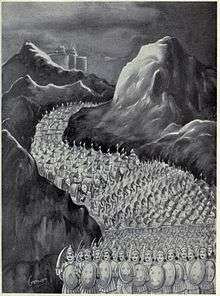Akshauhini
An akshauhini (Sanskrit: अक्षौहिणी akṣauhiṇī) is described in the Mahabharata as a battle formation consisting of 21,870 chariots (Sanskrit ratha); 21,870 elephants (Sanskrit gaja); 65,610 horses (Sanskrit turaga) and 109,350 infantry (Sanskrit pada sainyam) as per the Mahabharata (Adi Parva 2.15-23).[1][2] Thus one akshauhini consisted of 218,700 warriors (not including the charioteers, who didn't fight). The ratio is 1 chariot : 1 elephant : 3 cavalry : 5 infantry soldiers. In each of these large number groups (65,610, etc.), the digits add up to 18.
It is mentioned in the Mahabharata that, in the Kurukshetra War, the Pandava Army consisted of 7 akshauhinis (1,530,900 warriors), and Kaurava Army consisted of 11 akshauhinis (2,405,700 warriors). Thus, the total count of warriors who participated in the war, being 3,936,600.
Composition
One elephant (Gaja), one chariot (Ratha), three horses (Ashwa) and five foot soldiers (Padhata) form a Patti;
Three Pattis form a Sena-Mukha;
Three Sena-Mukhas make a Gulma;
Three Gulmas a Gana;
Three Ganas a Vahini;
Three Vahinis a Pruthana;
Three Pruthanas a Chamu;
Three Chamus an Anikini;
Ten Anikinis form an Akshauhini. Thus an Akshauhini, by calculation, contains 21,870 elephants, 21,870 chariots, 65,610 Horses, and 109,350 foot soldiers.
Kuru Army of 11 Akshauhinis is formed by the kingdom of Hastinapura in alliance with races like the Samsaptakas, Trigartas, the Narayana army, the Sindhu army and Shalya of Madra.
Commanders in Chief:
- Bhishma (10 days),
- Drona (5 days),
- Karna (2 days),
- Shalya (1 day),
- Ashwatthama (after Duryodhana loses the mace match with Bhima)
Kaurava Army and Duryodhana's side
- Bhagadatta the veteran - 1 Akshauhini
- Shalya, king of Madra - 1 Akshauhini
- Karna, king of Anga - 1 Akshauhini
- Kritavarma (Krishna's Narayani sena of Yadavas) - 1 Akshauhini
- Jayadratha (Saindhava) - 1 Akshauhini
- Sudakshina, king of Kambhoja - 1 Akshauhini (has Yavanas & Sakas in his troops)
- Bahlika, King of Bahlika Kingdom - 1 Akshauhini
- Kalinga Forces - 1 Akshauhini
- Shakuni of Gandhara - 1 Akshauhini
- Susharma of Trigarta - 1 Akshauhini
- Kurus and other Allies - 1 Akshauhini
Pandava Army: is a coalition of 7 Akshauhinis, primarily the Panchala and Matsya forces, the Rakshasa forces of Bhima's son, and Vrishni -Yadava heroes.

Pandava Army and their Allies
- Satyaki of the Vrishni clan - 1 Akshauhini
- Malaydhwaja king of Early Pandyas having a Conjugated armed force of Pandyas, Cholas and Cheras- 1 Akshauhini
- Dhrishtaketu, king of Chedis - 1 Akshauhini
- Sahadeva, son of Jarasandha - 1 Akshauhini (from Magadha)
- Drupada with his sons - 1 Akshauhini
- Virata the king of Matsya - 1 Akshauhini
- Ghatotkatch and other allies - 1 Akshauhini
The 4 types of units that make up an Akshauhini can also be seen in Chaturanga, the predecessor of chess.
See also
- Padmavyuha
- Chaturanga
- Maharathi (warrior)
